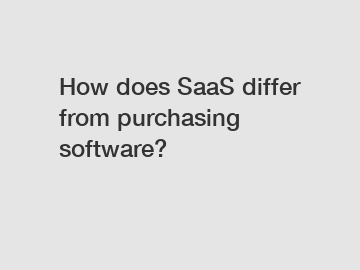How does SaaS differ from purchasing software?
How does SaaS differ from purchasing software?
Software as a Service (SaaS) is a revolutionary concept that has transformed the way businesses and individuals access and use software. Unlike traditional software purchasing, where users buy a perpetual license upfront to install and run the software on their own infrastructure, SaaS allows users to access and use software applications over the internet on a subscription basis. This fundamental difference has significant implications and benefits for both users and vendors.
The shift from purchasing software to using SaaS can be attributed to several key factors. Firstly, SaaS offers a more cost-effective solution for users. Instead of investing large sums of money upfront to buy software licenses, which would also require additional expenses for hardware and maintenance, users can pay a predictable monthly or annual subscription fee for SaaS. This reduces the financial barrier to access software, particularly for small and medium-sized businesses.

Additionally, SaaS eliminates the need for users to manage and maintain the underlying infrastructure and software. With traditional software purchasing, users are responsible for installation, updates, patches, backups, and security measures. In contrast, SaaS vendors handle all these technical aspects, allowing users to focus on their core business activities. This not only saves time and resources but also ensures that users always have access to the latest version of the software without any hassle.
Moreover, SaaS offers greater flexibility and scalability. Since the software is accessible over the internet, users can access it from any device with an internet connection, providing freedom and mobility. SaaS also allows users to easily adjust their subscription plans based on their changing needs. This scalability enables businesses to quickly adapt to growth or fluctuations in demand, without the need for significant investment in additional infrastructure or licenses.
The impact of SaaS extends beyond just financial and operational benefits. The shift towards SaaS has fostered a culture of innovation and collaboration among software vendors. With traditional software purchasing, vendors often had infrequent release cycles due to the time and effort required for development, testing, and distribution. SaaS allows vendors to release updates and new features more frequently and seamlessly. This not only ensures that users have access to the latest advancements but also allows vendors to gather valuable feedback and continuously improve their offerings.
In conclusion, SaaS and traditional software purchasing differ in terms of cost-effectiveness, ease of management, flexibility, and scalability. SaaS offers a more affordable and hassle-free alternative to purchasing software licenses, allowing users to access and use software over the internet on a subscription basis. The shift towards SaaS has transformed the software industry, benefiting both users and vendors through improved accessibility, reduced costs, increased collaboration, and continuous innovation.
Contact us to discuss your requirements of customize parcel delivery management software, paperless Parcel Logistics System, SaaS basis Logistics ERP. Our experienced sales team can help you identify the options that best suit your needs.



Comments
0